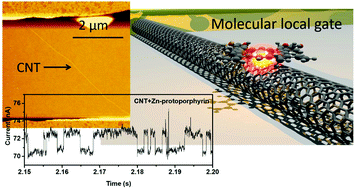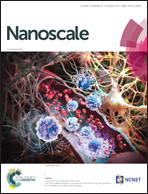Room-temperature discrete-charge-fluctuation dynamics of a single molecule adsorbed on a carbon nanotube†
Abstract
Detection and use of physical noise fluctuations in a signal provides significant advantages in the development of bio- and neuro-sensing and functional mimicking devices. Low-dimensional carbon nanomaterials are a good candidate for use in noise generation due to the high surface sensitivity of these materials, which may themselves serve as the main building blocks of these devices. Here, we demonstrate that the addition of a molecule with high redox activity to a carbon nanotube (CNT) field-effect transistor provides tunable current fluctuation noise. A unique charge-trap state in the vicinity of the CNT surface due to the presence of the single molecule is the origin of the noise, which generates a prominent and unique slow discrete random telegraph signal in the device current. The power spectral density reveals the peculiar frequency limit of the fluctuation for different types of molecules depending on their redox activity and adsorption configuration. These results indicate that the detected noise will provide new opportunities to obtain electronic information for a single molecule combined with a nanotube surface, and that controllability of the noise may contribute to the expansion of noise utilization in future bio-inspired devices.



 Please wait while we load your content...
Please wait while we load your content...